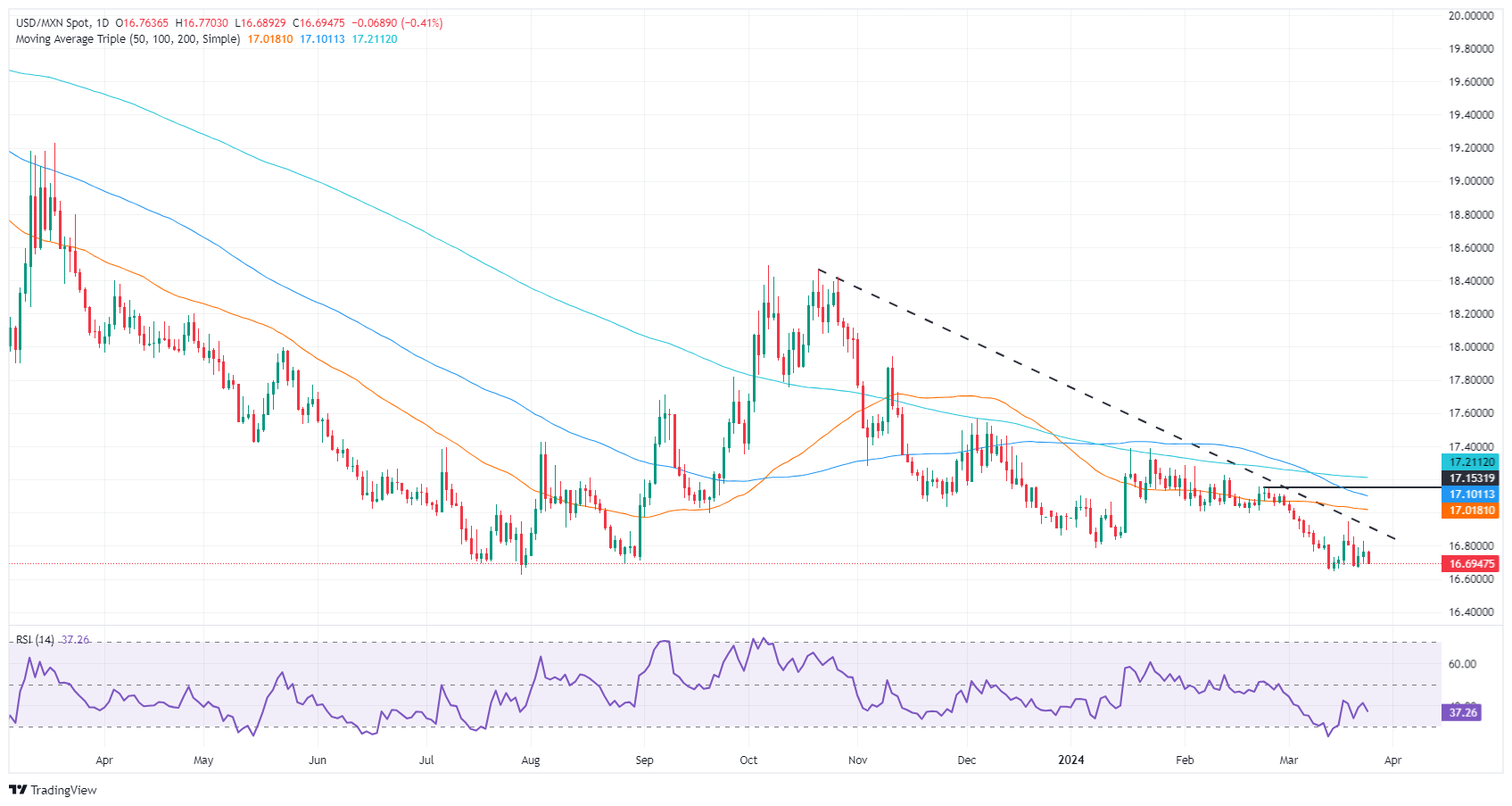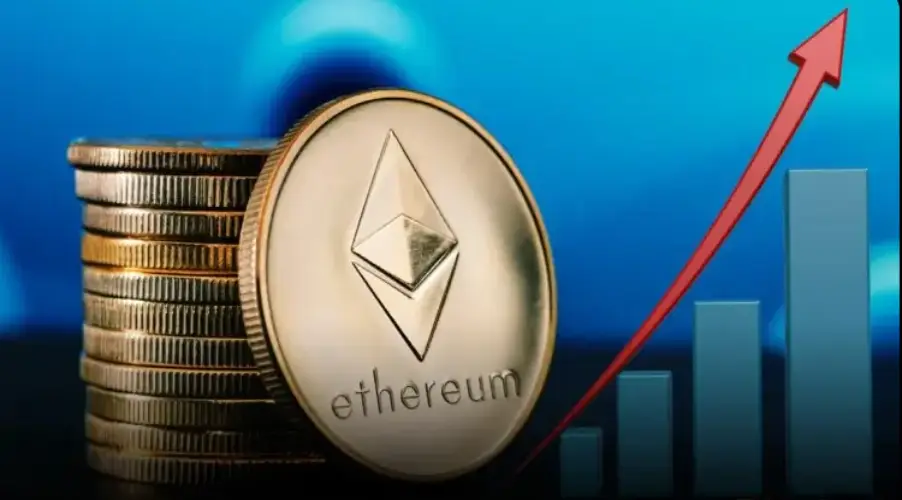- The Mexican peso benefits from the weakness of the US dollar, despite Banxico's rate cut.
- The governor of Banxico emphasized caution when adjusting rates, emphasizing the fight against inflation.
- Mixed economic data from both Mexico and the US leaves traders weighing the Fed's rate cut talk against actual data.
The Mexican Peso benefited from US Dollar weakness on Monday, rising more than 0.1% in the North American session. The downward momentum in risk was no excuse for the bulls of the Mexican currency, despite the interest rate cut carried out last week by the Bank of Mexico (Banxico). In addition, traders ignored comments from members of the Federal Reserve (Fed), as the Dollar remains under pressure. The USD/MXN pair is trading at 16.69, down 0.28%.
Mexico's economic agenda is absent, although the governor of Banxico, Victoria Rodríguez Ceja, made statements. She said the first rate cut does not mean the battle against inflation is over. She added that the central bank will be gradual and that adjustments to the main reference rates will be made taking into account upcoming data.
Last week, the National Institute of Statistics (INEGI) revealed that the economy contracted in January compared to December, while inflation in the middle of the month increased in monthly and annual terms.
Across the border, Federal Reserve officials had made briefing statements. Atlanta Fed President Raphael Bostic favored a rate cut this year, while Chicago Fed President Austan Goolsbee foresees three cuts in the federal funds rate (FFR). At the same time, Fed Governor Lisa Cook commented that a premature rate cut could increase the risk of inflation taking hold.
The real estate market data, the Chicago Fed's national activity index and the Dallas Fed's manufacturing index stand out on the US agenda.
Daily summary of market developments: The Mexican peso takes advantage of the weakness of the US dollar in Monday's session
- The governor of Banxico, Victoria Rodríguez Ceja, said: “When macroeconomic conditions and inflationary prospects allow us to make additional adjustments to the reference rate that we already have, I consider that they would be gradual.”
- Mexico's economy contracted for the fourth time in January. The General Indicator of Economic Activity fell -0.6% monthly, below estimates of a 0.3% expansion, and slowed compared to December, missing estimates of 2.6% to print at 2%. Inflation in Mexico surpassed estimates of 4.45%, rising 4.48%, while underlying figures jumped above the consensus of 4.62% annually to 4.69%.
- The outlook in Mexico suggests that the economy is stagnant. The weakness of the retail sales report, the sharp drop in private spending and the contraction in economic activity justified Banxico's rate cut. However, they face stubborn inflation, which keeps policymakers on edge.
- The US economic calendar has featured Fed speakers, led by Atlanta Fed President Raphael Bostic, who said he expects only one rate cut this year, adding that cutting rates too soon could be more harmful. At the same time, his colleague, Chicago Fed President Austan Goolsbee, sticks with the board's majority and expects three cuts, although he said he needs more evidence that inflation “is coming down.”
- Recently, Fed Governor Lisa Cook echoed Raphael Bostic's comments, stating that cutting too soon increases the risk of inflation taking hold. She added that the Fed's dual mandate goals are moving toward greater balance.
- New home sales in February decreased -0.3% monthly, from 0.664 million to 0.662 million. The Chicago Fed National Activity Index improved from -0.54 to 0.05. According to the Chicago Fed, all four categories that make up the index improved during the month.
- Recently, the Dallas Fed Manufacturing Index fell again from -11.3 in February to -14.4 in March. Wages and prices rose during the month, while expectations for future manufacturing activity improved overall.
Technical Analysis: Mexican Peso Gains Momentum and USD/MXN Falls Below 16.70
USD/MXN remains biased lower after reaching 16.94, last week's high. Since then, the pair has fallen 1.45% and is about to record additional losses. If the pair falls below the current year's low of 16.64, that could clear the way to test last year's cycle low of 16.62 and the October 2015 low of 16.32.
For a bullish scenario, traders need to reclaim the current week's high of 16.94, before the 17.00 level. Below are key dynamic resistance levels such as the 50-day SMA at 17.01, the 100-day SMA at 17.11, and the 200-day SMA at 17.20.
USD/MXN Price Action – Daily Chart

Inflation FAQ
Inflation measures the rise in prices of a representative basket of goods and services. General inflation is usually expressed as a monthly and annual percentage change. Core inflation excludes more volatile items, such as food and fuel, which can fluctuate due to geopolitical and seasonal factors. Core inflation is the figure economists focus on and is the target level of central banks, which are mandated to keep inflation at a manageable level, typically around 2%.
The Consumer Price Index (CPI) measures the variation in prices of a basket of goods and services over a period of time. It is usually expressed as a percentage of monthly and annual variation. Core CPI is the target of central banks as it excludes food and fuel volatility. When the underlying CPI exceeds 2%, interest rates usually rise, and vice versa when it falls below 2%. Since higher interest rates are positive for a currency, higher inflation usually translates into a stronger currency. The opposite occurs when inflation falls.
Although it may seem counterintuitive, high inflation in a country drives up the value of its currency and vice versa in the case of lower inflation. This is because the central bank typically raises interest rates to combat higher inflation, attracting more inflows of global capital from investors looking for a lucrative place to park their money.
Gold was once the go-to asset for investors during times of high inflation because it preserved its value, and while investors often continue to purchase gold for its safe haven properties during times of extreme market turmoil, this is not the case. most of the time. This is because when inflation is high, central banks raise interest rates to combat it. Higher interest rates are negative for Gold because they increase the opportunity cost of holding Gold versus an interest-bearing asset or placing money in a cash deposit account. On the contrary, lower inflation tends to be positive for Gold, as it reduces interest rates, making the shiny metal a more viable investment alternative.
Source: Fx Street
I am Joshua Winder, a senior-level journalist and editor at World Stock Market. I specialize in covering news related to the stock market and economic trends. With more than 8 years of experience in this field, I have become an expert in financial reporting.







